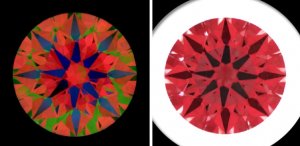- Joined
- Oct 21, 2004
- Messages
- 5,096
From my rather short experience in this cutting arena I dont think there is a clear border that differentiate between X & VG.Date: 4/21/2010 3:13:21 PM
Author: Karl_K
At some point it becomes physically impossible to line them up at the ex level that varies by facet, is there a downgrade before that point?Date: 4/21/2010 1:36:32 PM
Author: oldminer
Thanks for the advisory. Seems interesting, at least to me, that the symmetry we can measure objectively may have a noticeable range before the symmetry grade is lowered to the Very Good step. As a follow-up,. Are there a range of crown angles from high to low which would lower always the Symmetry grade from Ex to VG? Such grade setting points always are of interest although not the way anyone would suggest to select a diamond.
its a combination of numerous factors...
For example, take Todd Gray''s comment above


"what if the flow of the facets went something like 34.5 | 34.9 | 34.8 | 34.7 | 34.9 | 34.8 | 34.7 | 34.9 | it might be something you would want to take into consideration?"
And then combining the following Pav angles in correlation: "40.4 | 40.7 | 40.8 | 40.9 | 40.8 | 40.7 | 40.9 | 41.0 |"
I didnt test it..., but in such case (I believe) due to the nature of the overall precision cut other parameters would move out of sync of the overall excellent symmetry level required, like culet/table (tilt) off-center or a wide range of girdle thickness that would automatically display the "above mentioned "border".
Many more examples are available depending on facet designs.
On a side note to all involved in this discusion..., please take into consideration that scan error stands at 3-4 tenths of a degree (AND NOT ALWAYS AT THE SAME POSITION







300x240.png)